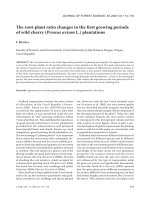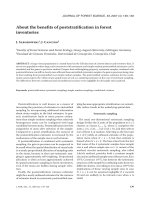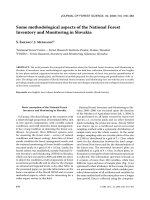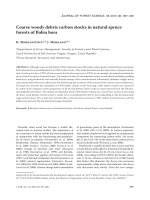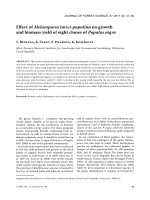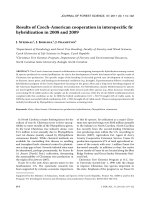Báo cáo lâm nghiệp:" Mature trees versus seedlings: Differences in leaf traits and gas exchange patterns in three co-occurring Mediterranean oaks" docx
Bạn đang xem bản rút gọn của tài liệu. Xem và tải ngay bản đầy đủ của tài liệu tại đây (311.08 KB, 6 trang )
455
Ann. For. Sci. 60 (2003) 455–460
© INRA, EDP Sciences, 2003
DOI: 10.1051/forest:2003038
Original article
Mature trees versus seedlings: Differences in leaf traits and gas
exchange patterns in three co-occurring Mediterranean oaks
Sonia MEDIAVILLA*, Alfonso ESCUDERO
Departamento de Ecología, Facultad de Biología, Universidad de Salamanca, 37071 Salamanca, Spain
(Received 19 February 2002; accepted 1 August 2002)
Abstract – We studied gas-exchange patterns and leaf traits of seedlings and mature trees of three coexisting Mediterranean oaks with
contrasting leaf habits (the evergreen Quercus ilex, and the deciduous Q. faginea and Q. pyrenaica) during the well-watered part of the growth
season. Leaf life span in Q. ilex seedlings was shorter than in mature trees, whereas for the deciduous species the differences in leaf life span
between both growth stages were less pronounced. In all species leaves on seedlings displayed a lower mass per unit area and lower nitrogen
content than on mature trees. However, owing to their larger stomatal conductance, leaves on seedlings usually showed larger photosynthetic
nitrogen-use efficiency and lower water-use efficiency than on mature trees. Stomatal conductance and CO
2
assimilation rate were lower in
Q. ilex than in the two deciduous species at the mature stage. However, the interspecific differences in gas exchange rates related to differences
in leaf longevity disappeared at the seedling stage because in Q. ilex the seedlings showed a much higher stomatal conductance than the adults.
Thus, seedlings of the three species showed a common strategy, regardless of the leaf life span, probably as a response to the competition from
the herbaceous layer.
growth stages / leaf gas-exchange / leaf traits / Quercus sp.
Résumé – Arbres adultes versus semis : différences de caractéristiques foliaires des types d’échanges gazeux chez trois espèces
coexistantes de Quercus. Les échanges gazeux et les caractéristiques foliaires des semis et des arbres adultes de trois espèces coexistantes de
chênes méditerranéens présentant des caractéristiques foliaires contrastées (une espèce à feuille persistante Quercus ilex et deux espèces à
feuille caduque Q. faginea et Q. pyrenaica) ont été étudiés lors des phases les plus favorables de la saison de croissance. La longévité foliaire
des semis a été inférieure à celle des adultes pour Q. ilex et similaire pour les deux autres espèces. Les feuilles des semis ont un poids plus faible
par unité de surface et une moindre teneur en azote que celle des adultes. Cependant, à cause de leur plus forte conductance stomatique, les
semis ont montré une meilleure efficience d’utilisation de l’azote dans la photosynthèse et une plus faible efficience d’utilisation de l’eau que
les arbres adultes. La conductance stomatique et l’assimilation de CO
2
ont été plus faibles pour Q. ilex par rapport aux deux autres espèces à
l’état adulte. Cependant, les différences interspécifiques dans les échanges gazeux ont disparu au stade semis, et les semis de Q. ilex ont présenté
une conductance stomatique beaucoup plus forte que les arbres adultes. Les plantules de trois espèces ont donc présenté une stratégie commune,
indépendamment de leur longévité foliaire, vraisemblablement en réponse à la concurrence de la strate herbacée.
stades de croissance / échanges gazeux foliaires / caractéristiques foliaires / Quercus sp.
1. INTRODUCTION
Seedling establishment and juvenile growth are critical
periods in the life cycle of tree species [20], and the morpho-
logical and physiological leaf attributes during these periods
are key factors for recruitment and survival of tree popula-
tions. Furthermore, many aspects of leaf morphology and
physiology may vary with tree age [11, 28]. Comparative stud-
ies of different growth stages may provide essential informa-
tion for understanding the strategies adopted by the species at
different stages of their life cycle, as well as the selective pres-
sures that operate in each stage.
Differences in the development of the root system between
adults and seedlings result in differences in water availability
and in water use strategies [9, 31, 32]. For this reason, most
studies comparing seedlings and adults in woody species have
mainly focussed on the analysis of the water relations and on
the effect of water stress on patterns of gas exchange and
mortality during the two developmental stages [3–5, 14–16].
Less emphasis has been placed on the comparison of the
patterns of leaf gas-exchange of seedlings and adults during
the part of the growth season free of drought stress. The
patterns of gas exchange in spring can also be of great
importance for seedling survival because they determine the
* Corresponding author:
456 S. Mediavilla, A. Escudero
amount of photosynthates available for the development of the
root system. Moreover, transpiration during spring partly
controls subsequent soil water availability.
In this study we analysed the leaf traits and patterns of gas-
exchange during the well-watered part of the growth season in
mature trees and seedlings of three co-occurring Quercus spe-
cies. Very few comparative studies [3, 5, 16] have been made
on seedlings and mature specimens of oaks growing in the
field under similar conditions. And, to our knowledge, none of
these has been made in Mediterranean climates, where the
short duration of the growth season [22] lends special rele-
vance to the gas-exchange rates obtained during the short
favourable season.
Our objective was to find out whether the strategies of gas-
exchange and photosynthetic resource-use in the more favour-
able part of the growth season differed between seedlings and
adults and to analyse the relationships between leaf traits and
gas exchange at the two stages. Strong relationships between
leaf N content and gas exchange rates have frequently been
observed when comparing species with different leaf longevi-
ties [18, 26]. Usually species with longer leaf life span display
lower leaf N contents and gas exchange rates [25, 27]. How-
ever, the relationships between N content and photosynthesis
can be affected by compromises between maximising carbon
gain and water conservation [19]. We predicted that the leaves
of seedlings in Mediterranean climates should maintain a less
conservative water use strategy than the adults, owing to the
need to compete for soil water resources with the herbaceous
layer, and that this should contribute to reduce the interspecific
differences in gas exchange rates related to differences in leaf
longevity at seedling stage.
2. MATERIALS AND METHODS
2.1. Study species and area
The study was carried out during three years (1995–1997) on adult
trees and seedlings of the evergreen species Quercus ilex L. subsp.
ballota (Desf.) Samp. (= Quercus rotundifolia Lam.) and the decidu-
ous species Q. faginea Lam. and Q. pyrenaica Willd. All species
were growing in five plots located close to the city of Salamanca, in
central-western Spain, between latitudes 41° 10´ N and 40° 50´ N and
longitudes 6° 35´ W and 5° 40´ W. Altitudes ranged between » 750
and 900 m above sea level. Quercus ilex L. subsp. ballota is charac-
teristic of the interior of the Iberian Peninsula, where climate is more
severe than close to coasts. The two deciduous species predominate
in the regions with milder or oceanic climates [29]. However, the
three species coexist in large areas of the interior Iberian Peninsula
and were present in each of the selected plots.
Three plots consisted of sparse populations (about 50 trees ha
–1
)
of isolated mature trees over 100 years old with open pasture areas
among them. Such savannah-like formations (“dehesas”) are very fre-
quent in the western part of the Iberian Peninsula. Trunk diameter at
1.3 m height ranged from 20 to 60 cm and mean heights were about
6–10 m. Seedlings were studied in the two other plots, planted at a
density of 1000 ha
–1
. Plantation was carried out during November
prior to the first year of our study with seedlings obtained from acorns
collected in areas close to the studied stands, and which were grown
in a nursery during one year. During the last growth season (four years
of age) the height of the seedlings was around 40–60 cm, whereas the
maximum diameter of the trunk varied between 7–10 mm for the two
deciduous species and 4–6 mm for Q. ilex. The two planted plots were
frequently subjected to weed control.
The soils, distric cambisol in all cases, are poor in organic matter
and in nutrients, with a low pH and medium/low water retention
capacity. Clay content ranges between 17 and 24%; silt, 14–16% and
sand between 61–64%. The climate is cold Mediterranean, with a
mean annual temperature between 11 and 13 °C. Annual precipitation
ranges between 400–650 mm, of which approximately 20–25% usu-
ally corresponds to spring (data provided by the National Institute of
Meteorology, Valladolid Centre). Rainfall is scarce during the
months of July and August, and summer drought occurs every year.
2.2. Gas-exchange measurements
Gas-exchange measurements were carried out in the field, during
late spring and early summer (before the onset of drought). Measure-
ments were taken from 7.00 to 10.00 a.m. (solar time), thus avoiding
the time of the day with heat stress. The CO
2
assimilation figures may
thus be regarded as an estimate of the maximum assimilation rate of
each leaf type. Measurements were taken weekly on completely
expanded leaves at mid height in the canopy. The leaves from seed-
lings and adults received full sunlight during the measurement period.
On adult trees, leaves were selected on three or four individuals of
each species in each plot. In seedlings, however, the number of indi-
viduals selected in each species in each plot was increased to 10,
owing to the greater variability between individuals observed during
this growth stage. Approximately 40 leaves of each type were
included in the final estimates of photosynthetic capacity for adult
trees and around 80 samples of each leaf type in seedlings. In the ever-
green species the two age-classes present in the crown were studied.
The measurements were taken with a portable photosynthesis sys-
tem (LI-6200, Li-Cor Inc., Lincoln, NE, US) at ambient CO
2
concen-
tration (around 360 mL·L
–1
), air temperatures between 20 and 35 °C,
relative humidities between 20–50% and saturating photosynthetic
photon flux density (above » 800 mmol m
–2
s
–1
). All leaves were col-
lected and taken to the laboratory for subsequent processing.
2.3. Sample processing and variables estimated
After gas-exchange measurements, leaf area (Delta-T Image
Analysis System, Delta-T Devices Ltd., Cambridge, UK), dry weight
(after drying at 60 °C until constant weight) and N concentration (CE-
Instruments NA-2100 autoanalyzer, ThermoQuest, Milan, Italy)
were measured. Leaf mass per unit area (LMA), N concentration per
unit mass (N
mass
), N concentration per unit area (N
area
), CO
2
assim-
ilation per unit mass (A
mass
), CO
2
assimilation per unit area (A
area
)
and instantaneous nitrogen-use efficiency (PNUE), as the ratio
between A
area
and N
area
, were derived from these data. The A
area
/g
ratio (assimilation per unit area/stomatal conductance) was taken as
an estimate of water use efficiency for a given vapour pressure deficit
(intrinsic water-use efficiency).
In order to calculate leaf life span in the adults, sampling of
branches with leaves from different crown positions of each canopy
was performed on 4 specimens of each species selected at random in
each plot at monthly intervals over 3 years of study. The samples
were immediately taken to the laboratory and separated into shoots of
different classes. Sub-samples of 40–50 shoots were used to calculate
the average number of leaves per shoot in each month and for each
age-class. In the seedlings, at monthly intervals over the three years
of study we estimated the total number of leaves of each age-class
present in the crown in 10 specimens selected for each species in each
plot. The different leaf cohorts produced within a year were distin-
guished by marking with coloured wires. The mean number of leaves
per shoot of a given age on each census date were used to elaborate
life tables, which made it possible to calculate the mean life span for
Mature trees vs. seedlings in oaks 457
the leaves of each species according to the standard methods [2].
Maximum leaf life span was estimated with the same procedure but
using only 25% of the initial leaf cohort with a higher persistence. For
seedlings the data obtained were averaged for the different leaf
cohorts produced within a year.
2.4. Statistical analyses
For analysis of the data we used the SPSS statistical package
(SPSS Inc., Chicago, IL). Two-way analysis of variance and Fisher’s
protected LSD test were used to establish significant difference at P £
0.05 between means after applying the Levene test to check for
homogeneity of variances.
3. RESULTS
3.1. Leaf characteristics: interspecific comparisons
and tree age-related differences
Patterns of leaf emergence varied between seedlings and
mature trees. In seedlings there were several flushes of leaf
emergence, hence the total leaf biomass per tree increased
gradually during spring (Fig. 1). In mature trees there was only
one flush at the beginning of the growth season so that the
maximal leaf biomass was reached rapidly. In Q. ilex seed-
lings a severe mortality was observed in the leaves during the
autumn-winter immediately after their emergence. Thus,
mean leaf life span was only about 9 months in Q. ilex seed-
lings versus almost 2 years in adult trees (Tab. I). By contrast,
in Q. faginea seedlings many leaves were retained green until
following spring (Fig. 1). Consequently, the mean leaf life
span of Q. faginea seedlings was larger than that of mature
trees by approximately one month (Tab. I). For Q. pyrenaica
seedlings the mean leaf life span was, on average, approxi-
mately one month less than that of adults.
In all cases, leaf mass per unit area (LMA) and leaf nitrogen
content were significantly lower in seedlings than in mature
trees, although the differences in N content between seedlings
and adults were less intense in Q. ilex than in the deciduous
species (Fig. 2). Within each growth stage, there were signifi-
cant interspecific differences in LMA. Highest values were
reached in leaves of the evergreen species, and among these in
one-year-old leaves (Fig. 2). Nitrogen content per unit leaf
mass (N
mass
) was significantly larger in the deciduous species
than in Q. ilex, both in adults and in seedlings (Fig. 2),
although the interspecific differences were less intense among
seedlings. With respect to the nitrogen content per unit area
(N
area
), there were no significant differences between the cur-
rent-year leaves of the adults of the three species. In contrast,
in the seedlings Q. ilex reached a significantly higher average
N
area
than the deciduous species (Fig. 2).
3.2. Leaf gas-exchange: interspecific comparisons
and tree age-related differences
Maximum daily stomatal conductance was higher on aver-
age in Q. ilex and Q. faginea seedlings than in the mature trees
of the same species, particularly in the case of Q. ilex (Fig. 3).
In Q. pyrenaica, however, maximum conductance was almost
identical for both growth stages. In contrast, the seedlings of
the two deciduous species maintained significantly lower CO
2
assimilation values per unit leaf area (A
area
) than their coun-
terparts from mature trees. Similarly, despite the high stomatal
conductance they exhibited, the assimilation rates of the
Q. ilex seedlings were similar to those of the mature trees
Figure 1. Some examples of leaf survivorship curves in seedlings
and mature trees of Q. ilex and Q. faginea.
Table I . Mean and maximum (age at 25% survivorship) leaf
longevity of the species studied.
Species Growth
stage
Mean leaf
longevity (days)
Maximum leaf
longevity (days)
Q. ilex trees 723 1140
Q. ilex seedlings 275 573
Q. faginea trees 204 315
Q. faginea seedlings 229 397
Q. pyrenaica trees 160 258
Q. pyrenaica seedlings 124 213
458 S. Mediavilla, A. Escudero
(Fig. 3). Thus, intrinsic water-use efficiency (A
area
/g) was in
all cases significantly lower in the seedlings than in the adults
(Fig. 4). In contrast, photosynthetic nitrogen-use efficiency
was significantly higher in the younger trees in Q. ilex and
Q. faginea, and not significantly different between seedlings
and adult trees in Q. pyrenaica (Fig. 4). Finally, the assimila-
tion rate per unit leaf mass (A
mass
) did not reflect a general
trend in the comparisons between growth stages (Fig. 3).
Among mature trees, the evergreen species displayed on
average lower CO
2
assimilation rates, both per unit leaf area
and per unit leaf mass, and lower stomatal conductance than
deciduous ones (Fig. 3). In the seedlings also Q. pyrenaica
showed the highest stomatal conductance. However, hardly
any difference was observed between the conductance values
obtained in Q. ilex and Q. faginea. The leaves of Q. faginea
seedlings displayed largest CO
2
assimilation rates per unit
area. Among the other leaf types, the differences were not sig-
nificant (Fig. 3). On the contrary, A
mass
values were similar in
the two deciduous species and significantly higher in them
than in Q. ilex (Fig. 3).
Mean intrinsic water-use efficiency was similar in mature
Q. ilex and Q. faginea trees and significantly lower in
Q. pyrenaica (Fig. 4). In the seedlings, however, A/g was sim-
ilar in Q. ilex and Q. pyrenaica, and significantly lower in both
cases than in Q. faginea. Finally, the photosynthetic nitrogen-
use efficiency in the mature trees was significantly different
for all the leaf types, with the highest values corresponding to
Q. pyrenaica and the lowest to Q. ilex (Fig. 4). In the seed-
lings, however, although once again Q. ilex showed lower
PNUE, the differences did not reach significance in the two
deciduous species (Fig. 4).
Figure 2. Mean (±S.E.) leaf mass per unit area (LMA) and leaf N
concentration per unit area (Narea) and per unit mass (Nmass) in
mature trees (dotted bars, n = 40) and in seedlings (open bars, n = 80).
For each leaf type different numbers within the bars indicate
significant differences (P < 0.05) between adults and seedlings.
Dotted bars with different uppercase letters above indicate significant
differences (P < 0.05) among leaf types for mature trees. Open bars
with different lowercase letters above indicate significant differences
(P < 0.05) among leaf types for seedlings. In Q. ilex current- (C) and
1-year-old (C + 1) leaves are included.
Figure 3. Mean (±S.E.) maximum stomatal conductance (g) and CO
2
assimilation rate per unit area (Aarea) and per unit mass (Amass) in
mature trees (dotted bars, n = 40) and in seedlings (open bars, n = 80).
For each leaf type different numbers within the bars indicate
significant differences (P < 0.05) between adults and seedlings.
Dotted bars with different uppercase letters above indicate significant
differences (P < 0.05) among leaf types for mature trees. Open bars
with different lowercase letters above indicate significant differences
(P < 0.05) among leaf types for seedlings. In Q. ilex current- (C) and
1-year-old (C + 1) leaves are included.
Mature trees vs. seedlings in oaks 459
4. DISCUSSION
Significant morphological and physiological differences
were observed between leaves of mature trees and seedlings.
One problem associated with the approach used in this study
is the possible genetic differences between mature specimens
and the seedlings used in the afforestation, which could evi-
dently contribute to the physiological and morphological dif-
ferences between growth stages. In addition, transplanting
stress can affect the physiological performance of the seed-
lings for some time after plantation. However, the differences
observed in the present study between the two growth stages
were so large that it is unlikely that they arose only from the
above-mentioned possible artefacts. Within a growth stage,
the differences between different stands were not significant
(data not shown) and the interspecific comparisons yielded
similar results in all stands. There is no reason to expect that
genetic distance between the seedlings and the adults will be
higher than between the adult specimens studied in the differ-
ent plots. Finally, transplanting stress should especially affect
the results obtained during the first year of the study. How-
ever, the results obtained this first year could not be distin-
guished from those obtained during the remainder of the study
period (data not shown).
Mature trees exhibited larger LMA, larger leaf N content
and lower maximum stomatal conductance than the seedlings,
as other authors have also observed in several oak species
[1, 5, 16, 17, 28]. However, the extent of the difference
between growth stages varied among the three species studied,
as suggested by the significant interaction term in the two-way
ANOVA found for most of the variables (data not shown).
Q. ilex was the species for which the most pronounced differ-
ences in stomatal conductance between growth stages were
obtained. As a consequence, in the seedlings the interspecific
differences differed from those we and many other authors
have observed in mature trees. Thus, in the mature trees, a
lower stomatal conductance and assimilation rate was associ-
ated with a longer leaf life span, greater LMA and smaller
N
mass
, as several authors have reported [21, 25, 27]. By contrast,
among the seedlings, neither the interspecific differences in
the maximum stomatal conductance nor in the photosynthetic
rates can be fully explained by the leaf life span, although
PNUE was still clearly lower in Q. ilex seedlings than in the
two deciduous species, owing to the effects associated with the
greater LMA [23].
In principle, this result might be attributed to the relatively
small interspecific differences in the mean leaf life span in
seedlings in comparison with the mature trees, mainly because
of the short leaf life span of the Q. ilex seedlings. However, the
maximum leaf life span was still greater in Q. ilex seedlings
than in the deciduous species (Tab. I), which seems to indicate
that the leaves of Q. ilex seedlings are also designed to reach a
greater life span than those of the two deciduous species.
Indeed, Q. ilex seedlings, in comparison with the deciduous
species, continued to exhibit traits proper to a species of longer
leaf life span, such as smaller N
mass
and greater LMA.
The seedlings of the three species apparently tend to max-
imise their stomatal conductance under favourable conditions,
despite the fact that such high conductance resulted in very
low water-use efficiency during the early stages of develop-
ment (Fig. 4), as other authors have also observed in different
species [5, 14, 15]. Taking into account that water shortage is
a strong limiting factor in our regions with Mediterranean cli-
mate, how then can we explain the strategy shown by the seed-
lings and the differences with respect to the more conservative
water use strategy of the adults?
Probably the peculiarities of the ecophysiology of the seed-
lings are a response to the intense competition for soil water
they usually have to cope with, both from herbaceous vegeta-
tion and from other trees [7, 10]. Oaks have rapid root growth
and produce deep taproots as seedlings [8, 30]. However, it
may take some years to pass the maximum penetration depth
of the roots of the herbaceous plants and thus reduce their
competitive effects ([3, 31], Mediavilla, personal observa-
tion). Maintaining high water-use efficiency through strong
stomatal control would imply lower net CO
2
assimilation rates
and, therefore, a reduction in growth. Furthermore, conserva-
tion of the soil water reserves would increase the availability
of soil water for potential competitors [6, 12]. A low water-use
efficiency in benefit of an increase in growth and a strong allo-
cation to the root biomass would probably be a more success-
ful strategy under the competitive conditions that the seedlings
experience during their establishment [13].
In short, our results reveal that the strong physiological
interspecific differences at leaf level in the adults related to dif-
ferences in leaf life span tend to decrease and even disappear
Figure 4. Mean (±S.E.) intrinsic water use efficiency (Aarea/g) and
photosyntetic nitrogen use efficiency (PNUE) in mature trees (dotted
bars, n = 40) and in seedlings (open bars, n = 80). For each leaf type
different numbers within the bars indicate significant differences
(P < 0.05) between adults and seedlings. Dotted bars with different
uppercase letters above indicate significant differences (P < 0.05)
among leaf types for mature trees. Open bars with different lowercase
letters above indicate significant differences (P < 0.05) among leaf
types for seedlings. In Q. ilex current- (C) and 1-year-old (C + 1)
leaves are included.
460 S. Mediavilla, A. Escudero
at the seedling stage. Some authors [24] postulate important
differences in total production and growth between seedlings
of species that differ in leaf life span, which, nevertheless, are
thought to attenuate during the adult stage because of the accu-
mulation of several leaf cohorts in the species with longer leaf
life span. However, in our case it seems that the interspecific
differences in leaf life span show a smaller effect on the phys-
iological differences at leaf level in seedlings than in mature
trees, and this should contribute to reduce the differences in
growth rate between species differing in leaf longevity. Con-
tinuing research in this field in order to analyse the effects of
leaf traits on the growth rate of seedlings of different species
and to determine in which stage of the ontogeny of the different
species the maturing of the physiological traits of the leaves
occurs could provide very useful information for clarifying the
relations of competition between the different species.
Acknowledgements: This paper has received financial support from
the Spanish Ministry of Education (Projects No. FOR89-0845 and
AMB95-0800) and from the Junta de Castilla y León (Projects No.
SA47/95 and SA72/00B). We thank two anonymous reviewers for
helpful comments on the manuscript.
REFERENCES
[1] Acherar M., Rambal S., Comparative water relations of four
Mediterranean oak species, Vegetatio 99/100 (1992) 177–184.
[2] Begon M., Harper J.L., Townsend C.R., Ecology. Individuals,
Populations and Communities, Blackwell Science, Oxford, 1996.
[3] Bragg W.K., Knapp A.K., Briggs J.M., Comparative water
relations of seedling and adult Quercus species during gallery
forest expansion in tallgrass prairie, For. Ecol. Manage. 56 (1993)
29–41.
[4] Brown J.R., Archer S., Water relations of a perennial grass and
seedlings vs adult woody plants in a subtropical savanna, Texas,
Oikos 57 (1990) 366–374.
[5] Cavender-Bares J., Bazzaz F.A., Changes in drought response
strategies with ontogeny in Quercus rubra: implications for scaling
from seedlings to mature trees, Oecologia 124 (2000) 8–18.
[6] Cohen D., The expected efficiency of water utilization in plants
under different competition and selection regimes, Isr. J. Bot. 19
(1970) 50–54.
[7] Collet C., Guehl J.M., Frochot H., Ferhi A., Effect of two forest
grasses differing in their growth dynamics on the water relations
and the growth of Quercus petraea seedlings, Can. J. Bot. 74 (1996)
1562–1571.
[8] Danner B.T., Knapp A.K., Growth dynamics of oak seedlings
(Quercus macrocarpa Michx. and Quercus muhlenbergii Engelm.)
from gallery forests: implications for forest expansion into
grasslands, Trees 15 (2001) 271–277.
[9] Davis S.D., Mooney H.A., Tissue water relations of four co-
occurring chaparral shrubs, Oecologia 70 (1986) 527–535.
[10] Davis M.A., Wrage K.J., Reich P.B., Tjoelker M.G., Schaeffer T.,
Muermann C., Survival, growth, and photosynthesis of tree
seedlings competing with herbaceous vegetation along a water-
light-nitrogen gradient, Plant Ecol. 145 (1999) 341–350.
[11] Day M.E., Greenwood M.S., White A.S., Age-related changes in
foliar morphology and physiology in red spruce and their influence
on declining photosynthetic rates and productivity with tree age,
Tree Physiol. 21 (2001) 1195–1204.
[12] De Lucia E.H., Schlesinger W.H., Resource-use efficiency and
drought tolerance in adjacent Great Basin and Sierran plants,
Ecology 72 (1991) 51–58.
[13] De Lucia E.H., Schlesinger W.H., Billings W.D., Water relations
and the maintenance of Sierran conifers on hydrothermally altered
rock, Ecology 69 (1988) 303–311.
[14] Donovan L.A., Ehleringer J.R., Ecophysiological differences
among juvenile and reproductive plants of several woody species,
Oecologia 86 (1991) 594–597.
[15] Donovan L.A., Ehleringer J.R., Contrasting water-use patterns
among size and life-history classes of a semi-arid shrub, Funct.
Ecol. 6 (1992) 482–488.
[16] Donovan L.A., Pappert R.A., Ecophysiological differences among
growth stages of Quercus laevis in a sandhill oak community, J.
Torrey Bot. Soc. 125 (1998) 3–10.
[17] Epron D., Dreyer E., Picon C., Guehl J.M., Relationship between
CO
2
dependent O
2
evolution and photosystem II activity in oak
(Quercus petraea) trees grown in the field and in seedlings grown
in ambient or elevated CO
2
, Tree Physiol. 14 (1994) 725–733.
[18] Field C., Mooney H.A., The photosynthesis-nitrogen relationship
in wild plants, in: Givnish T.J. (Ed.), On the economy of plant form
and function, Cambridge University Press, Cambridge, 1986,
pp. 25–55.
[19] Field C., Merino J., Mooney H.A., Compromises between water
use efficiency and nitrogen use efficiency in five species of
California evergreens, Oecologia 60 (1983) 384–389.
[20] Kozlowski T.T., Kramer P.J., Pallardy S.G., The Physiological
Ecology of Woody Plants, Academic Press, New York, 1991.
[21] Mediavilla S., Escudero A., Heilmeier H., Internal leaf anatomy
and photosynthetic resource-use efficiency: interespecific and
intraspecific comparisons, Tree Physiol. 21 (2001) 251–259.
[22]Mitrakos K.A., A theory for Mediterranean plant life, Acta Oecol. 1
(1980) 245–252.
[23] Poorter H., Evans J.R., Photosynthetic nitrogen-use efficiency of
species that differ inherently in specific leaf area, Oecologia 116
(1998) 26–37.
[24] Reich P.B., Variation among plant species in leaf turnover rates and
associated traits: implications for growth at all life stages, in:
Lambers H., Poorter H., Van Vuuren M.M.I. (Eds.), Inherent
variation in plant growth. Physiological mechanisms and ecological
consequences, Backhuys Publishers, Leiden, The Netherlands,
1998, pp. 467–487.
[25] Reich P.B., Walters M.B., Ellsworth D.S., Leaf life span in relation
to leaf, plant, and stand characteristics among diverse ecosystems,
Ecol. Monogr. 62 (1992) 365–392.
[26] Reich P.B., Walters M.B., Ellsworth D.S., Uhl C., Photosynthesis-
nitrogen relations in Amazonian tree species. I. Patterns among
species and communities, Oecologia 97 (1994) 62–72.
[27] Reich P.B., Ellsworth D.S., Walters M.B., Vose J.M., Gresham C.,
Volin J.C., Bowman W.D., Generality of leaf trait relationships: A
test across six biomes, Ecology 80 (1999) 1955–1969.
[28] Thomas S.C., Winner W.E., Photosynthetic differences between
saplings and adult trees: an integration of field results by meta-
analysis, Tree Physiol. 22 (2002) 117–127.
[29] Tutin T.G., Heywood V.H., Burges N.A., Valentine D.H., Walters
S.M., Webb D.A., (Eds.), Flora Europaea, Cambridge, University
Press, London, 1964.
[30] Weaver J.E., Kramer J., Root system of Quercus macrocarpa in
relation to the invasion of prairie, Bot. Gaz. 94 (1932) 51–85.
[31] Weltzin J.F., McPherson G.R., Spatial and temporal soil moisture
resource partitioning by trees and grasses in a temperate savanna,
Arizona, USA, Oecologia 112 (1997) 154–164.
[32] Wilson T.B., Witkowski E.T.F., Water requeriments for
germination and early seedling establishment in four African
savanna plant species, J. Arid Environ. 38 (1998) 541–550.

